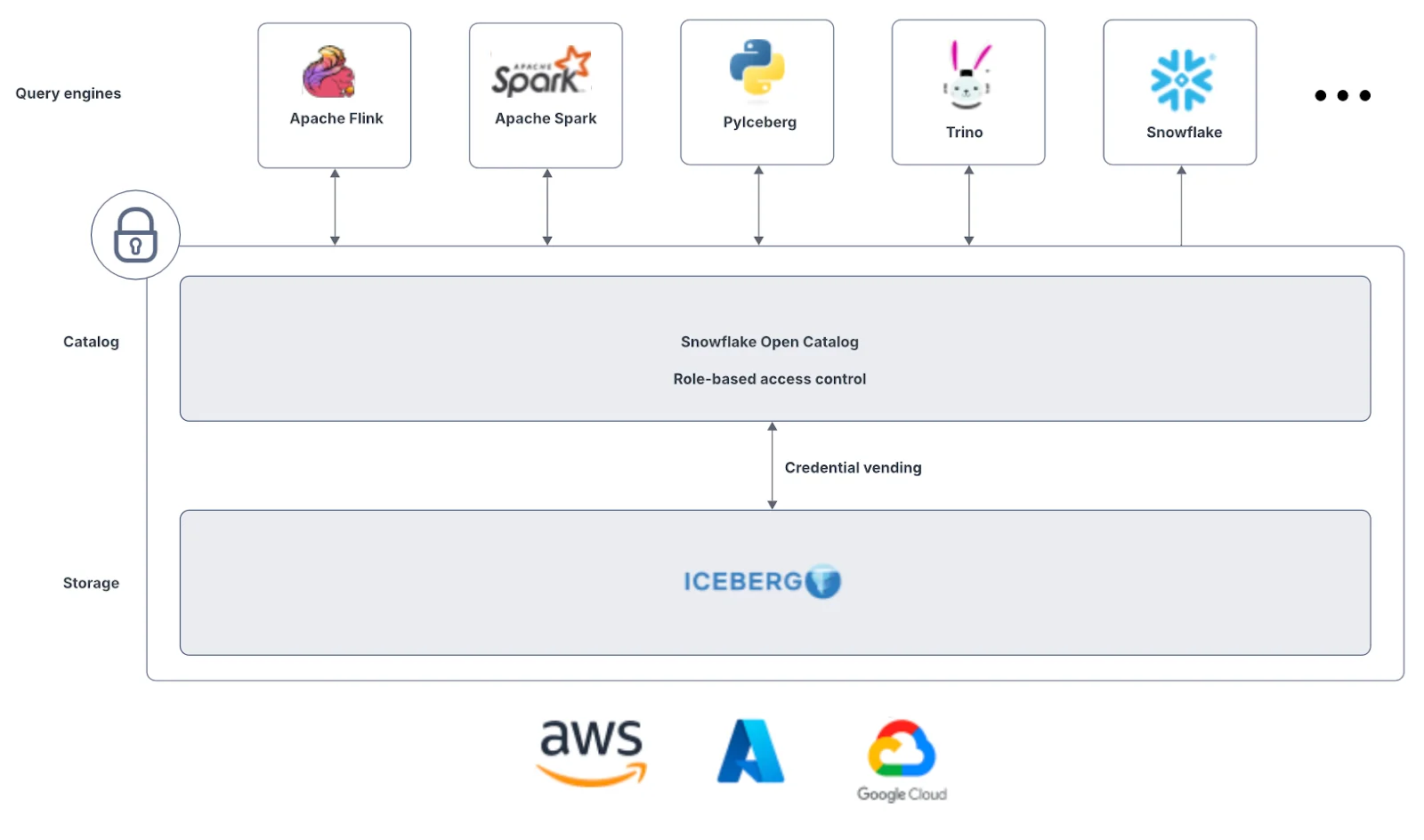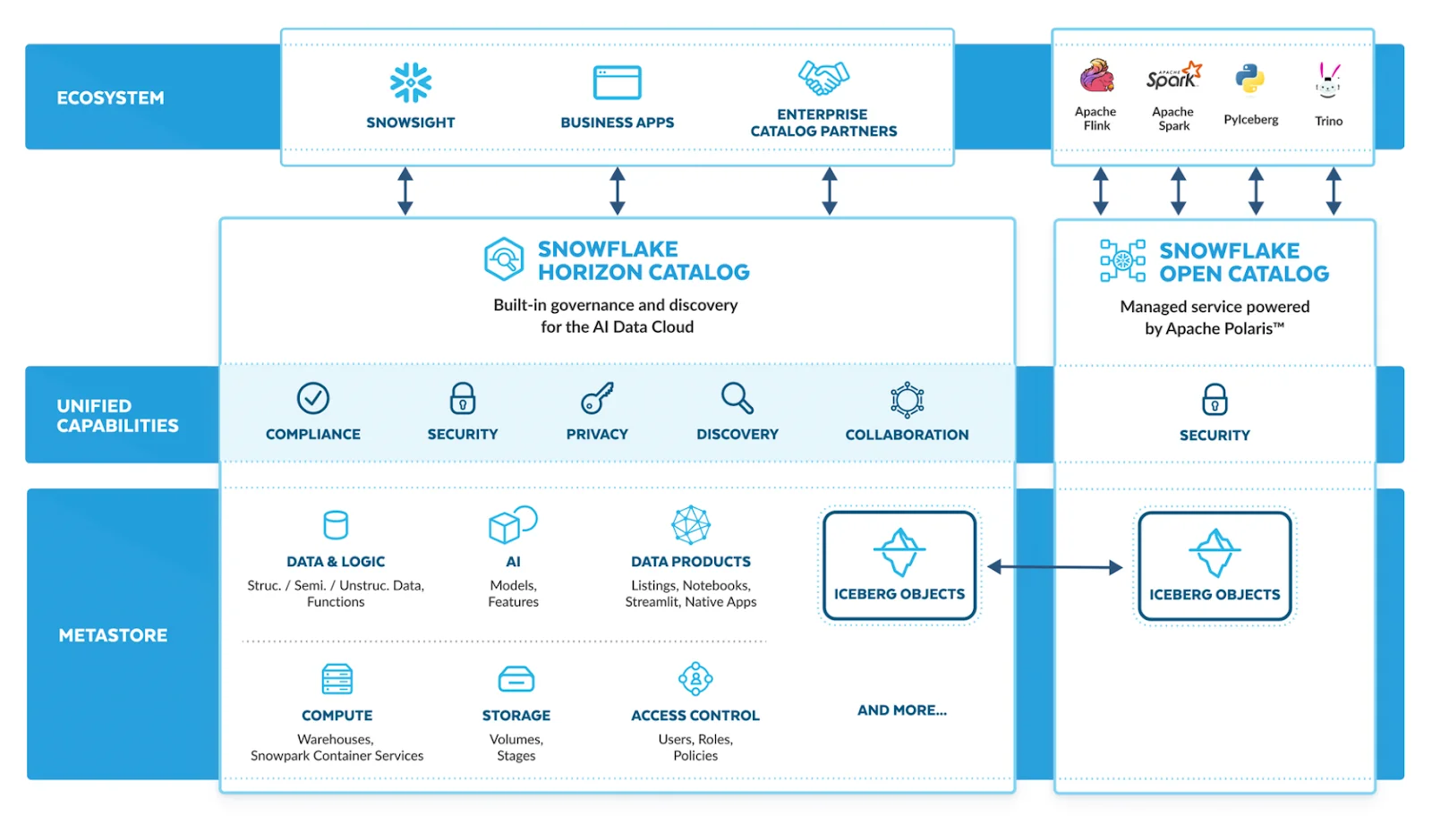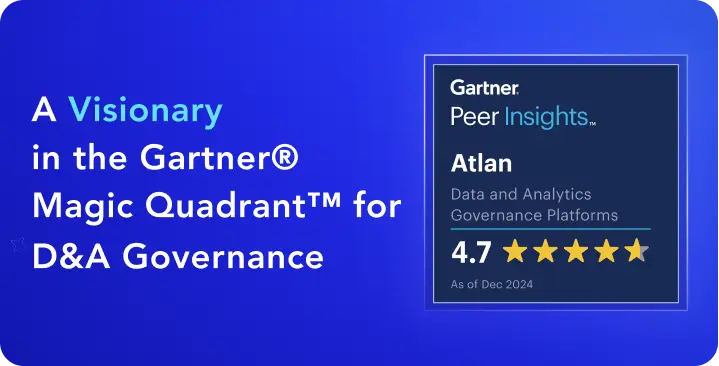Snowflake Data Catalog: Expanding Native Functionality with Unified Metadata Control Plane
Share this article
Snowflake data catalog refers to metadata management features that help users discover, understand, and manage their data assets. Snowflake exposes technical metadata through ACCOUNT_USAGE and READER_ACCOUNT_USAGE schemas, though these offer limited cross-platform visibility.
To expand its cataloging capabilities, Snowflake introduced the Open Catalog (open API access), Polaris Catalog (Iceberg-native), and Horizon Catalog (built-in UI for discovery and governance).
Scaling AI on Snowflake? Here’s the playbook - Watch Now
However, to fully leverage your data, you need a unified control plane that connects metadata across systems like AWS Glue, Iceberg REST, object storage, and Polaris. In this article, we’ll explore:
- Snowflake’s built-in data cataloging features
- The need for a unified control plane for your Snowflake ecosystem
- How leading companies across industries are leveraging the Snowflake-Atlan integration to unlock the complete potential of their data estate
Table of Contents #
- What are Snowflake’s native data cataloging features?
- Why do you need a unified, metadata control plane for your Snowflake and non-Snowflake data assets?
- Snowflake and Atlan integration: Customer success across industries
- Final thoughts on Snowflake data catalog
- Snowflake data catalog: Frequently asked questions (FAQs)
- Snowflake data catalog: Related reads
What are Snowflake’s native data cataloging features? #
Snowflake provides several out-of-the-box cataloging capabilities, primarily targeted at technical users. These include:
- ACCOUNT_USAGE and READER_ACCOUNT_USAGE schemas in the SNOWFLAKE database, which track query history, login activity, object usage, roles, and more
- Additional metadata schemas like DATA_SHARING_USAGE, MONITORING, and TELEMETRY, which capture metadata for specific use cases
- Information Schema — a read-only technical dictionary that provides granular metadata for tables, columns, procedures, privileges, and more
Save Your Seat To See Atlan in Action - Live Demo Series
Snowflake also captures metadata around features like:
- Data classification (e.g., PII tagging)
- Object tagging for governance and automation
- Masking policies and row-level access policies
- Data metric functions (DMFs) for quality monitoring
To support broader use cases like cross-platform analytics, Iceberg-based workloads, and intuitive data discovery, Snowflake introduced:
- Polaris Catalog: Snowflake’s Iceberg-native catalog, based on open standards, and compatible with Apache Iceberg’s REST catalog specifications.
- Open Catalog: Exposes metadata to external engines like Apache Spark or Trino using open APIs.
- Horizon Catalog: The closest thing to a built-in Snowflake data catalog for search, discovery, and governance within the Snowflake interface.
Polaris Catalog for an open, Iceberg-native architecture #
Launched in July 2024, Polaris Catalog represents a significant shift toward open and interoperable data architecture.
It supports Apache Iceberg, the fast-growing open table format designed for large-scale analytics across engines like Apache Spark, Trino, Flink, and Dremio and is built on open REST APIs.
With Polaris Catalog, Snowflake’s goal is to create a unified, vendor-neutral catalog that aligns with its commitment to interoperability. This is to allow organizations to manage data within Snowflake alongside other platforms like AWS, Microsoft Azure, and Google Cloud without traditional data "lock-in”.
Open catalog for third-party interoperability #
Snowflake’s Open Catalog is a managed service for Apache Polaris™ (incubating). It provides a way to expose Snowflake’s metadata to external query engines (such as Trino, Presto, and Spark) using open APIs. This improves interoperability with the broader data ecosystem and supports federated data access.

Snowflake’s Open Catalog - Source: Snowflake Documentation.
Horizon Catalog for data discovery and governance within Snowflake #
The Horizon Catalog is Snowflake’s built-in enterprise data catalog focused on user-friendly search, discovery, and governance — directly within the Snowflake UI. It brings together key capabilities like data search, asset certification, tag-based classification, and policy management, among others.
At the heart of the Horizon Catalog is a “unified, global repository for the Snowflake AI Data Cloud, which includes structured, semi-structured and unstructured data; models; Snowflake Notebooks; Streamlit; Snowflake Native Apps; and listings.”
Snowflake Horizon Catalog is meant to offer a suite of capabilities around Security, Compliance, Privacy, Discovery and Collaboration.

Snowflake Horizon Catalog - Source: Snowflake.
Why do you need a unified, metadata control plane for your Snowflake and non-Snowflake data assets? #
While Snowflake’s catalogs serve distinct roles — from Iceberg management to UI-based discovery — they still operate within the Snowflake environment. Most modern organizations rely on multiple tools, platforms, and data sources (e.g., Databricks, AWS Glue, BigQuery, Looker, dbt) that sit outside Snowflake’s visibility.
You need a full-fledged metadata control plane that integrates with all systems in your data stack, offering complete control over the search, discovery, and governance of your data assets.
This is where Atlan comes into play as the unified metadata control plane for your entire data ecosystem.
Atlan as a unified control plane for Snowflake #
The rapid growth of data tools and technologies, along with the explosion in data volume, has triggered an evolution of metadata into big data. This shift makes a Lakehouse approach to metadata essential for gaining full control and maximizing its value.
Such an approach enables the creation of advanced capabilities, including complex automation workflows and end-to-end data ecosystem enablement, all built on top of a lakehouse-driven metadata control plane.
Atlan has embraced this approach to handle Snowflake metadata effectively. Atlan builds on Snowflake’s catalog metadata and expands it across your entire data stack.
While Snowflake captures and manages this core data, Atlan enables you to extract value from it by helping you find relevant, trustworthy data assets, collaborate with peers through shared workspaces, and ensure data sharing is in compliance with your organization’s policies. These capabilities are crucial in today’s data- and AI-driven world.
How Atlan brings cataloging, discovery, and governance together for your entire data estate #
Unlike traditional data catalogs, Atlan uses a metadata-lakehouse approach, treating metadata like a product—open, API-first, and ready for activation across AI, ML, analytics, and compliance workflows.
Some of Atlan’s key capabilities that expand Snowflake’s cataloging experience and make your data estate AI-ready include:
- Discovery: Provides an intuitive user interface that allows you to search and discover data assets across all your source and target systems, including Snowflake, by tapping into its internal metadata layer.
- Governance: Enables data governance based on your organization’s operational model, extending Snowflake’s native governance features. It supports different governance models for various teams, accommodating compliance and regulatory requirements.
- Classification: Enhances data discovery and trust by applying certification and verification tags to data assets. This feature integrates with Snowflake’s native data classification and tagging, using a two-way syncing mechanism for Snowflake tags.
- Ownership: Facilitates the design and implementation of a data asset ownership model across your organization, which is particularly useful for data mesh architectures. While Snowflake assigns OWNERSHIP to securable objects, Atlan’s ownership model applies uniformly across your entire data ecosystem.
- Freshness: Automatically builds trust by signaling the freshness of data. This feature leverages Snowflake’s object metadata and customized queries to infer data freshness in tables or views.
- Cost optimization: Leverages usage pattern metadata to identify dormant or stale data assets, automating their deprecation to save on storage and compute costs. This feature helps streamline your data ecosystem by reducing unnecessary data complexity.
- Lineage: Maps the flow of data throughout your platform, providing visibility into how data is transformed from ingestion to consumption. Atlan extracts lineage metadata from Snowflake using both the
ACCOUNT_USAGEschema and theINFORMATION_SCHEMA.
Additionally, Atlan supports use cases such as automation, business glossary management, metadata activation, and personalization.
Snowflake and Atlan integration: Customer success across industries #
Atlan has been named a Leader in The Forrester Wave™, has proven its ability to empower organizations across diverse industries, from banking to healthcare, fintech, and manufacturing, have successfully integrated Snowflake with Atlan to modernize their data stack, streamline data governance, enable self-service access to data, and get the data AI-ready.
Here’s how these leading companies have transformed their data operations using this powerful combination:
- Austin Capital Bank (Banking) is a fast-growing, product-centric bank that adopted Snowflake and Atlan to modernize their data stack. The integration provided a seamless way to manage data access while ensuring governance. As Ian Bass, Head of Data & Analytics, put it, “Atlan gave us a simple way to see who has access to what."
- Scripps Health (Healthcare) leveraged the Snowflake-Atlan integration to manage sensitive healthcare data while adhering to HIPAA requirements. With Atlan tapping into Snowflake’s powerful metadata, they gained end-to-end visibility. “Since Atlan is virtualized on Snowflake, security is no longer a concern,” says Victor Wilson, Data Architect.
- Tala (FinTech) uses Snowflake as part of their data stack and integrates it with Atlan, dbt, and Looker. By automating the sync of dbt documentation into Snowflake through Atlan, Tala streamlines its data processes. This allows business users to access a unified data dictionary within Atlan, making data easily understandable.
- Aliaxis (Manufacturing), a global leader in water solutions, integrated Atlan with their Snowflake-powered data warehouse to enhance data visibility. Atlan serves as their primary point of reference for data-related queries, acting as a “bridge” to understand data within Snowflake. “If there’s any question you have about data in Snowflake, go to Atlan,” shares Nestor Jarquin, Global Data & Analytics Lead.
These stories highlight the transformative power of Snowflake and Atlan for businesses looking to enhance their data capabilities.
Final thoughts on Snowflake data catalog #
The modern data ecosystem is increasingly diverse, often spanning multiple cloud platforms and on-premises environments. Managing governance, compliance, and context across these systems requires a unified control plane—a single go-to platform that addresses all of your organization’s data needs, regardless of the data consumer’s role.
Atlan provides this unified control plane, seamlessly integrating with data ecosystems centered around Snowflake or any other SaaS or PaaS data platform. By doing so, Atlan becomes a critical component in helping your organization unlock the full value of its data.
Want to see how an Atlan-Snowflake integration can work for you? Book a demo today and discover the impact of Atlan + Snowflake for your organization.
Snowflake data catalog: Frequently asked questions (FAQs) #
1. What is the data catalog in Snowflake? #
The Snowflake data catalog refers to native metadata features that help users discover, understand, and manage data assets. These include system views like ACCOUNT_USAGE, INFORMATION_SCHEMA, as well as tools like Polaris Catalog, Open Catalog, and Horizon Catalog for governance and discovery.
2. Can I use Snowflake’s catalog with other data platforms? #
To some extent, yes. Snowflake’s Open Catalog exposes metadata through open APIs, allowing external engines like Apache Spark, Trino, and Presto to access Snowflake’s metadata for interoperability across platforms.
You can tap into integrations with tools like Atlan to enable cross-platform metadata management, allowing you to unify data from AWS, Azure, and Google Cloud.
3. How does Snowflake catalog data? #
Snowflake catalogs data through its ACCOUNT_USAGE schema and other dedicated schemas like DATA_SHARING_USAGE, MONITORING, and TELEMETRY. Snowflake also uses its built-in governance features like object tagging, data classification, data masking, and data metric functions (DMFs).
4. What is Snowflake Open Catalog? #
Snowflake Open Catalog is a managed service that allows external engines to access Snowflake metadata via REST APIs. It’s built on open standards and designed to support federated queries and interoperability with third-party tools.
5. Is Snowflake Horizon a catalog? #
Yes. Horizon Catalog is Snowflake’s built-in enterprise data catalog that lives within the Snowflake UI. It supports business-friendly search, discovery, data certification, tag-based classification, and governance workflows.
6. How can I create a catalog in Snowflake? #
Data cataloging in Snowflake is handled through built-in schemas, metadata views, and features like Horizon Catalog and Polaris for Iceberg-native workloads.
7. What benefits does a data catalog provide in Snowflake? #
A data catalog in Snowflake enhances data discovery, supports governance, simplifies access audits, and improves trust by surfacing metadata about data lineage, classification, access control, and quality metrics.
8. What are the benefits of using a metadata control plane with Snowflake? #
A metadata control plane like Atlan extends Snowflake’s native cataloging by integrating metadata across tools like dbt, Looker, and Airflow. It centralizes data governance, discovery, and compliance across platforms. This is crucial for managing data in modern multi-cloud environments and ensuring AI-readiness.
9. Can I automate data cataloging in Snowflake? #
Yes, partially. Snowflake automatically captures system and query metadata, and offers features like object tagging and classification. For full-fledged automation, you can use integrations with third-party tools like Atlan, which helps unify and streamline metadata collection across platforms, reducing manual tasks and enhancing data catalog accuracy.
Snowflake data catalog: Related reads #
- Snowflake Summit 2025: How to Make the Most of This Year’s Event
- Snowflake Cortex: Everything We Know So Far and Answers to FAQs
- Snowflake Copilot: Here’s Everything We Know So Far About This AI-Powered Assistant
- Polaris Catalog from Snowflake: Everything We Know So Far
- Snowflake Cost Optimization: Typical Expenses & Strategies to Handle Them Effectively
- Snowflake Horizon for Data Governance: Here’s Everything We Know So Far
- Snowflake Data Cloud Summit 2024: Get Ready and Fit for AI
- How to Set Up a Data Catalog for Snowflake: A Step-by-Step Guide
- How to Set Up Snowflake Data Lineage: Step-by-Step Guide
- How to Set Up Data Governance for Snowflake: A Step-by-Step Guide
- Snowflake + AWS: A Practical Guide for Using Storage and Compute Services
- Snowflake X Azure: Practical Guide For Deployment
- Snowflake X GCP: Practical Guide For Deployment
- Snowflake + Fivetran: Data movement for the modern data platform
- Snowflake + dbt: Supercharge your transformation workloads
- Snowflake Metadata Management: Importance, Challenges, and Identifying The Right Platform
- Snowflake Data Governance: Native Features, Atlan Integration, and Best Practices
- Snowflake Data Dictionary: Documentation for Your Database
- Snowflake Data Access Control Made Easy and Scalable
- Glossary for Snowflake: Shared Understanding Across Teams
- Snowflake Data Catalog: Importance, Benefits, Native Capabilities & Evaluation
- Snowflake Data Mesh: Step-by-Step Setup Guide
- Managing Metadata in Snowflake: A Comprehensive Guide
- How Can to Query Information Schema on Snowflake? Examples, Best Practices, and Tools
- Snowflake Summit 2023: Why Attend and What to Expect
- Snowflake Summit Sessions: 10 Must-Attend Sessions to Up Your Data Strategy
Share this article











